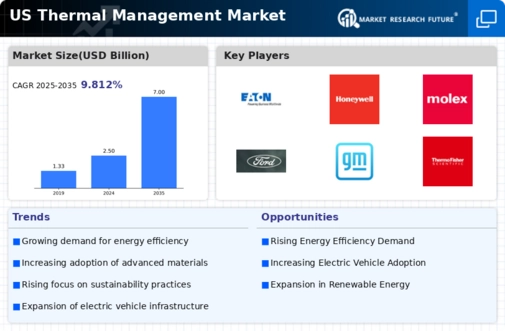The competitive landscape of the US Thermal Management Market is characterized by a diverse array of players, each vying to capitalize on the growing demand for efficient thermal solutions across various industries. Factors such as technological advancements, innovation in materials, and a rising awareness of energy efficiency are pivotal in shaping the dynamics of this market. Companies are increasingly focusing on developing advanced thermal management products and systems, including thermal interface materials, heat exchangers, and climate control solutions.
Amidst the continuous evolution of this market, strategic partnerships, mergers, and acquisitions are prevalent as companies seek to bolster their market share and enhance their capabilities in delivering cutting-edge thermal solutions. Eaton has established a formidable presence in the US Thermal Management Market, characterized by its strong reputation for innovation and reliability.
The company leverages its extensive engineering expertise to develop high-performance thermal management systems that cater to various application demands, including automotive, aerospace, and industrial systems. Eaton's strengths lie in its comprehensive product portfolio, which includes advanced cooling systems and thermal interface materials designed to meet the specific needs of its clients. With a focus on sustainability and energy efficiency, Eaton consistently improves its offerings to align with the evolving market trends. Their strategic initiatives, including investments in research and development, have further solidified their position as a leading provider in the thermal management sector within the United States.
Honeywell has also made significant strides in the US Thermal Management Market, known for its innovative approach and diverse product offerings. The company specializes in a wide array of thermal management solutions, including heating, ventilation, and air conditioning systems, as well as advanced temperature control technologies. Honeywell's strengths are evident in its robust market presence supported by strong customer relationships and a firm commitment to research and development, which allows them to deliver cutting-edge solutions tailored to customer needs.
The company has been active in expanding its capabilities through strategic mergers and acquisitions, further enhancing its footprint in the market. With a dedication to sustainable practices and a focus on smart technology integration, Honeywell continues to evolve its thermal management offerings, catering to both residential and commercial sectors across the country.





















Leave a Comment